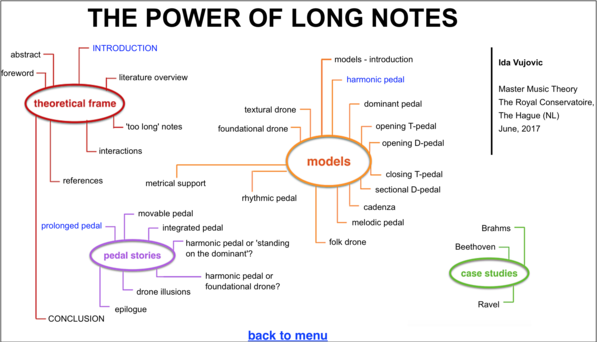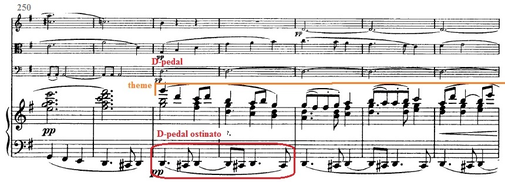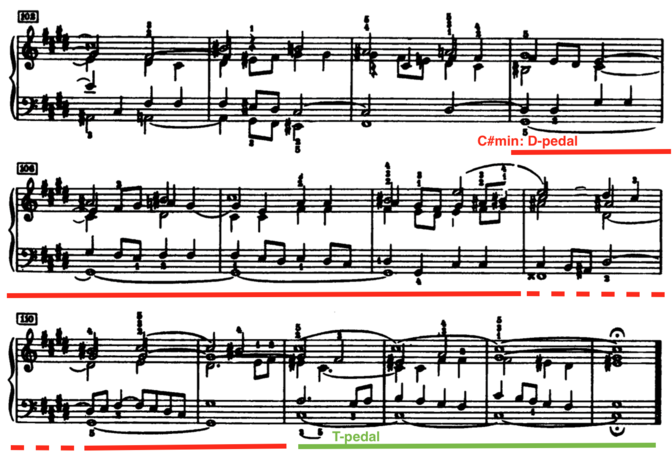Harmonic pedal: ‘Default type’
When hearing the word ‘pedal point’, most musicians and music theorists would think of a harmonic pedal, with a clear harmonic function, most probably the tonic or the dominant, in the bass. Once a tone is recognized as a pedal, this notion will arouse expectation of its resolution and termination. Customarily, the pedal tone starts as the root of the sounding chord (in case of a dominant pedal, it can also start with the 6/4 suspension). After the deviation takes place (the separation of the harmonic actors), the ear expects the return of that initial moment. This expectation is related to the concepts completion, closure, and the law of return (see Meyer, 1956). In the case of pedal, the tension between the two harmonic layers (the bass and the harmonic progression above it) will resolve when the two reunite, which will be felt as the completion of the pedal process, and the closure of the structural unit (longer motif, semi-phrase, phrase, etc.)
Most of the expectation, however, comes probably from the mere experience: once we have recognized harmonic pedal, we expect it to terminate after the moment it will rejoin the harmony again. In most cases these expectations are eventually fulfilled. However, as there are many possibilities for the exact chord progression above the pedal, we cannot be sure at which moment the final resolution will take place (the event we are waiting for). As the harmonic direction turns back toward the pedal-harmony, the expectation-tension grows.
Živković (1996) writes: “Different than other dissonances, it represents a particular harmonic function, independent from the other harmonic events.”[1] Harmonic pedal is thus a bass tone with clear harmonic identity. As a strong harmonic actor, it influences the way we perceive the other harmonic events. In this way, the result is a harmonic prolongation of its own harmonic function. It is crucial for harmonic pedal that there is a conflict between the two harmonic layers. A pedal tone that is all the time the root of the current harmony will not be considered being harmonic pedal, even if it is sustained for a long time (such as the famous introduction to Wagner’s Rheingold).
Harmonic pedal appears in two variants: the tonic and the dominant. Mulder (1947: 104) writes that both are in the service of the key, and that the latter intensifies the power of the dominant, while the former broadens the tonic-space. While both variants can occur anywhere in the structure, tonic pedal is more frequently used at the beginning or at the end (of the whole), and dominant pedal is more frequently used close to the end (of the whole or one of its parts).
Other scale degrees could also be sustained but they are rarely felt as harmonic pedals. When the supertonic or the mediant are prolonged, their pitch is often absorbed into the other harmonies (where possible), and we do not feel that the splitting of the harmonic field has taken place (the bass tone does not oppose the other harmonies with a clear harmonic function). Think, for example, of the second movement of Tchaikovsky’s 6th symphony:
In its second compound part (Trio), a pedal on D is present throughout, in the bass. When the first part, in stable D major, finishes with an authentic cadence, the bass tone D continues its rhythmic iteration as a pedal tone. The Trio begins on Bm chord, but the presence of D in the pedal competes for the tonic-role. As the theme further develops, the B-minor key convincingly wins this competition. When this happens, the pedal tone D loses its harmonic power. It does remain to sound, coloring the B-minor tonic with a bit of ‘relative-major-ness’. Next to this, it could also be perceived as a textural layer, deprived of its implicativeness.
Understanding only a tonic or a dominant pedal as a harmonic pedal has to do with the strength of the directive-ness of these two main harmonic functions. Next to this, tonic and dominant prolongation have a certain level of style-based implicative-ness. Other harmonic pedals are rarely in use, which means that the listener has poor experience with them, and has not a clear expectation of what could come next. Referring to Lewin’s model of perception (see the chapter ‘Interactions’), a pedal on another scale-tone is not yet a part of ‘the language’. When another pitch is sustained in the bass, it could be recognized as another model (for example textural drone), or it could be just a non-implicative sound that is consonant/dissonant/pleasing/irritating/low/high/ hard/soft/etc.
The listener’s familiarity with tonic and dominant harmonic pedals as models, or concepts, could be the reason to perceive any other sustained pitch in the bass as the (temporary) tonic or the dominant. For example, the Scherzo from the 9th symphony of Bruckner, in D minor, opens with an unusual opening-chord, A#half.dim.4/3. A long sustained C# sounds on the top of it. When this movement is heard out of the context of the whole symphony, the interaction of several elements could promote the C# as the foundation, even as the tonic.
In the absence of any bass tone, the C# on the top of the chord becomes more prominent. The end of the first melodic motif (orange) is a pure C#m arpeggio. The sense of ‘completeness’ of the bass-motif (orange) projects the importance on its last pitch, C#. This could be felt as a confirmation of C# and its establishment as a (temporary) foundation. In this case, the Bb turns into the M6 of the chord. When the melodic motifs reappear in a sequence, a 2nd up, and the harmony changes into D-major, this could be felt as a logical proceeding to the bII subdominant under the tonic pedal (bII, then in D-minor, was in the first movement an important chord). In the following chord progression, we can recognize the pattern that is very common for the opening T-pedal (which will be discussed in the related chapter): (V)iv-iv, even though this pedal is not in the bass.
If the opening chord is immediately perceived as A#half.dim.7, this could define another harmonic context, with other expectations.[2] Although the scherzo does not open in C# minor, and although C#m6 chord is les typical than its twin A#half.dim.7, several actors, including the pedal and the stored knowledge of harmonic-pedal models, could lead our perception in that direction. Pedal can thus be influential in perceiving the tonal plan of the composition. After the frist 42 bars of the introduction, the a section starts with a powerful, rhythmical striking of the ‘real’ tonic, D, in the lower registers. This new thundering pedal, a harmonic T-pedal, is one of the most characterizing elements of this scherzo.
The implicative-ness or directive-ness of harmonic pedal is strongly related also to its structural position in a phrase. Due to its strong tonal-functional determinacy, harmonic pedal (T or D) is usually placed either at the beginning or at the end of a phrase (or a section). This has also a reversed effect: this knowledge (experience) increases the closural power of harmonic pedal or its power to initiate. In other words, it increases the effect of pedal as a differentiating factor. This strength to influence structural differentiation is based on the expectation of change (this refers to the expectation of a beginning of a new motif/phrase/section, or the expectation of the end of the phrase). Both tonic and dominant pedal will terminate only after the harmonic progression has returned to the original chord, represented by the pedal.
Harmonic pedal does not actually have to sound.[3] A number of instruments cannot sustain the tone for a longer time and still long notes are scored for these instruments. The sustained pitch is indeed perceptible, but the sustained sound not always. Take, for example, Bach’s fugue in C# minor, from WTK I (previous example), played by Daniel Barenboim:
The arrival of the pedal is emphasized in this performance by a small ritardando and the accent on the bass note. The bass is soon not any more audible, only the upper voices remain. And, nevertheless, the bass is still present in the listener’s mind. The listener has perceived the splitting of the texture, the bass tone that has stopped its movement, and the other voices that have proceeded without the bass. The listener recognizes dominant pedal and the gesture of entering into the last, probably long cadence. The pedal tone is implicitly present, as the listener is waiting to hear its re-uniting with the harmony. Next to this, the register-space of the bass does not host any other note; there is no replacement, so the last tone could remain in our ears.[4]
Harmonic pedal does not need to be a prolonged note; it can be a repeated note or an ostinato pattern. When a reiterated note (pedal) gets melodic embellishments, this can result in a melodic ostinato pattern. Such pattern can ‘work’ as a harmonic pedal. The example below shows a pedal-ostinato on the dominant. Its power is built on the same elements as in the case of sustained dominant in the bass: splitting of the harmonic space, conflicting harmonic message of the two harmonic layers, expectation of the resolution and the termination of the pedal.
I have outlined just a few forms of a harmonic pedal (sustained sound, repetitive sound, implied sound, ostinato pattern), but the possibilities are many. As will be discussed in much detail in the text that follows, each is characterized with some extent of conflict in the harmonic realm, and some extent of expectation-based excitement that it incites. The actual sound of the (sounding) pedal is less of importance, despite the fact that it can have strong sonorous impact on the listener as well. In such cases I will speak of harmonic pedal with a degree of drone-ness (see the chapters ‘Introduction’ and ‘Too-long’ notes’).
Harmonic pedal appears in several distinguishable variants, that will be discussed in turn: D-pedal, ‘fanfare’ pedal, sectional D-pedal, opening T-pedal, and closing T-pedal. The concept known as ‘inverted pedal’ is, in this research, not seen as one particular model. Some instances of it will here be recognized as thematic pedal, others as pedal-ostinato in the upper voices.
next: Dominant Pedal or return to menu
[2] In this case, it would be G#minor: ii 4/3. Another possibility is hearing an altered vii6/5 in the home key, D minor (possible reference to Tristan chord).




